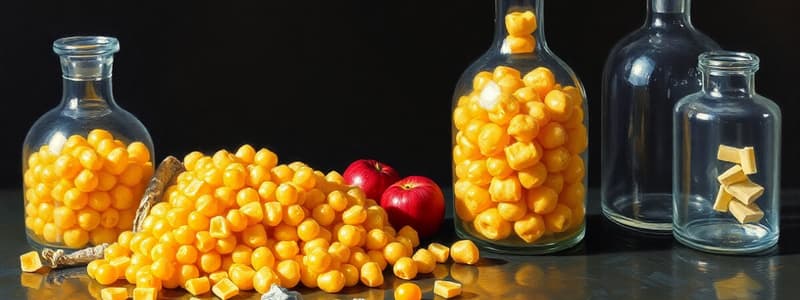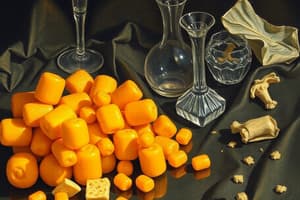Podcast
Questions and Answers
What is the general formula for carbohydrates?
What is the general formula for carbohydrates?
- (CH2)nO
- (C3H6O)n
- (C2H2O)n
- (CH2O)n (correct)
Which class of carbohydrates consists of single units of polyhydroxyaldehyde or ketone?
Which class of carbohydrates consists of single units of polyhydroxyaldehyde or ketone?
- Polysaccharides
- Disaccharides
- Monosaccharides (correct)
- Oligosaccharides
Which carbohydrate classification includes more than 20 monosaccharide units?
Which carbohydrate classification includes more than 20 monosaccharide units?
- Monosaccharides
- Disaccharides
- Oligosaccharides
- Polysaccharides (correct)
What type of bond links oligosaccharides?
What type of bond links oligosaccharides?
Which of the following roles do carbohydrates NOT perform?
Which of the following roles do carbohydrates NOT perform?
What configuration do most natural sugars have?
What configuration do most natural sugars have?
Which of the following is a characteristic of Fischer projection representations?
Which of the following is a characteristic of Fischer projection representations?
What term describes oligosaccharides that consist of two monosaccharide units?
What term describes oligosaccharides that consist of two monosaccharide units?
Which polysaccharide is known for its linear form?
Which polysaccharide is known for its linear form?
What is the smallest monosaccharide?
What is the smallest monosaccharide?
What role do selectins play in the immune response?
What role do selectins play in the immune response?
How do integrins function in relation to other cells?
How do integrins function in relation to other cells?
Eptifibatide is utilized primarily for which purpose?
Eptifibatide is utilized primarily for which purpose?
What is a key function of selectins during inflammation?
What is a key function of selectins during inflammation?
Which of the following best describes the role of Helicobacter pylori in inflammation?
Which of the following best describes the role of Helicobacter pylori in inflammation?
What is one of the main effects of integrins on leukocytes?
What is one of the main effects of integrins on leukocytes?
What characteristic of a lectin is primarily responsible for its function in cell adhesion?
What characteristic of a lectin is primarily responsible for its function in cell adhesion?
In which condition is Eptifibatide most commonly utilized?
In which condition is Eptifibatide most commonly utilized?
What is the significance of the glycosidic OH being free in reducing sugars?
What is the significance of the glycosidic OH being free in reducing sugars?
In the glucose oxidase method for measuring glucose levels, what is produced as a byproduct?
In the glucose oxidase method for measuring glucose levels, what is produced as a byproduct?
What differentiates reducing from non-reducing disaccharides?
What differentiates reducing from non-reducing disaccharides?
Which formula accurately represents the reduction of copper in the Fehling’s reaction with glucose?
Which formula accurately represents the reduction of copper in the Fehling’s reaction with glucose?
Which of the following statements about lactose is correct?
Which of the following statements about lactose is correct?
What is the impact of mutarotation on the reducing properties of sugars?
What is the impact of mutarotation on the reducing properties of sugars?
What type of polysaccharide is primarily broken down by the enzyme trehalase?
What type of polysaccharide is primarily broken down by the enzyme trehalase?
Which phenomenon is NOT associated with the properties of non-reducing sugars?
Which phenomenon is NOT associated with the properties of non-reducing sugars?
Which statement best describes the role of hexokinase in glucose metabolism?
Which statement best describes the role of hexokinase in glucose metabolism?
What is the primary component in the Clinitab® test for measuring glucose levels?
What is the primary component in the Clinitab® test for measuring glucose levels?
What is the main reason why D-glucose and D-galactose are classified as epimers?
What is the main reason why D-glucose and D-galactose are classified as epimers?
What will be the total number of stereoisomers for a sugar molecule with 4 chiral carbons?
What will be the total number of stereoisomers for a sugar molecule with 4 chiral carbons?
Which of the following best describes the structures formed by monosaccharides after cyclization?
Which of the following best describes the structures formed by monosaccharides after cyclization?
What is the difference between the anomers of glucose?
What is the difference between the anomers of glucose?
In what condition does mutarotation occur?
In what condition does mutarotation occur?
Which of the following statements about the conformational forms of pyranose rings is true?
Which of the following statements about the conformational forms of pyranose rings is true?
How many total stereoisomers can a monosaccharide with 5 chiral centers theoretically have?
How many total stereoisomers can a monosaccharide with 5 chiral centers theoretically have?
Which type of reaction is responsible for the formation of hemiacetals in monosaccharides?
Which type of reaction is responsible for the formation of hemiacetals in monosaccharides?
Why is the preferred chair conformation of alpha-D-glucopyranose more stable?
Why is the preferred chair conformation of alpha-D-glucopyranose more stable?
What is the result of having a sugar with D-relative configuration?
What is the result of having a sugar with D-relative configuration?
Which statement accurately describes the optical rotation at equilibrium for mutarotation of D-glucose?
Which statement accurately describes the optical rotation at equilibrium for mutarotation of D-glucose?
Which of the following is a feature unique to ketoses compared to aldoses?
Which of the following is a feature unique to ketoses compared to aldoses?
How do the anomers and diastereomers of a sugar differ fundamentally?
How do the anomers and diastereomers of a sugar differ fundamentally?
What is the main structural feature of cyclodextrins that facilitates drug encapsulation?
What is the main structural feature of cyclodextrins that facilitates drug encapsulation?
Which glycosidic bond linkage characterizes amylose?
Which glycosidic bond linkage characterizes amylose?
What distinguishes amylopectin from amylose?
What distinguishes amylopectin from amylose?
Which property of cellulose contributes to its mechanical strength?
Which property of cellulose contributes to its mechanical strength?
How is chitin structurally similar to cellulose?
How is chitin structurally similar to cellulose?
What is the primary role of starch in pharmaceutical formulations?
What is the primary role of starch in pharmaceutical formulations?
How do penicillins affect bacterial cell walls?
How do penicillins affect bacterial cell walls?
What are glycosidic bonds in peptidoglycans typically characterized by?
What are glycosidic bonds in peptidoglycans typically characterized by?
Which statement accurately describes glycogen?
Which statement accurately describes glycogen?
What kind of agents can be derived from cellulose to modify its properties?
What kind of agents can be derived from cellulose to modify its properties?
Which of the following best explains the mechanism of action of penicillins?
Which of the following best explains the mechanism of action of penicillins?
Which of these polysaccharides is classified as a fuel-storage homopolysaccharide?
Which of these polysaccharides is classified as a fuel-storage homopolysaccharide?
What significant structural difference is found between Gram-positive and Gram-negative peptidoglycans?
What significant structural difference is found between Gram-positive and Gram-negative peptidoglycans?
Flashcards are hidden until you start studying
Study Notes
Carbohydrates
- Polyhydroxyaldehydes or polyhydroxyketones with the general formula (CH2O)n, sometimes containing N, S, or P.
- Can be linear or cyclic.
- Also include oligomers and polymers, which form upon hydrolysis.
- Also called saccharides, named with the suffix “-ose”.
- Classified in monosaccharides, oligosaccharides, and polysaccharides.
Monosaccharides
- Single units of polyhydroxyaldehydes or ketones.
- Examples include glucose, fructose, erythrose.
Oligosaccharides
- Contain a few monosaccharide units linked via ether bonds.
- Sucrose is a disaccharide made up of one unit of D-glucose and one unit of D-fructose.
Polysaccharides
- Contain more than 20 monosaccharide units.
- Some have more than 100,000 units.
- Can be linear (e.g., amylose) or branched (e.g., amylopectin, glycogen).
Carbohydrate Roles
- Energy generation and storage: Oxidation of carbohydrates is the primary energy generating process in metabolism.
- Structural role in plants (cellulose), cell walls of bacteria, and exoskeleton of insects.
- Inactive ingredients in tablets, capsules, and other pharmaceutical formulations.
- Osmolites, contributing to osmotic pressure inside and outside the cells.
- Recognition elements in immunity, immune response, cell identity, and recognition.
Monosaccharides: Types and Nomenclature
- Two main types: polyhydroxyaldehydes (aldoses) and polyhydroxyketones (ketoses), determined by the position of the carbonyl group.
- Classified by the number of carbon atoms in the molecule, including trioses, tetroses, pentoses, and hexoses.
Monosaccharides: Chirality
- Smallest monosaccharide is glyceraldehyde, which has two stereoisomers.
- Most natural sugars have the D relative configuration, determined by the position of the hydroxyl group on the most distant chiral carbon from the carbonyl group.
Monosaccharides: Fischer Projection
- A two-dimensional representation of the three-dimensional molecular structure showing all chiral centers within a molecule.
- The longest carbon chain is written vertically with the most oxidized carbon at the top.
- Horizontal lines represent bonds projecting forward, vertical lines represent bonds projecting to the rear.
- Carbon atoms at the intersection of horizontal and vertical lines are not shown.
- Carbon atoms are numbered sequentially from the top.
- The D or L configuration is determined by the position of the hydroxyl group on the chiral carbon farthest from the carbonyl group: on the right for D configuration, and on the left for L configuration.
Carbohydrates: Classification and Structure
- Carbohydrates are organic compounds composed of carbon, hydrogen, and oxygen.
- They play crucial roles in living organisms, including energy storage, structural support, and cell recognition.
- Carbohydrates are classified based on their complexity: monosaccharides, disaccharides, oligosaccharides, and polysaccharides.
- Monosaccharides are the simplest sugars:
- They can be classified as aldoses (contain an aldehyde group) or ketoses (contain a ketone group).
- Each chiral carbon in a monosaccharide generates two enantiomers.
- The number of stereoisomers for a sugar with "n" chiral carbons is 2^n.
- Only half of these stereoisomers will have the D-relative configuration (found in most natural sugars).
- Epimers are two sugars that differ only in the configuration of one chiral carbon atom.
- Monosaccharides can exist in cyclic forms:
- The formation of a cyclic structure creates a new chiral center called the anomeric carbon.
- The two stereoisomers that differ in stereochemistry at the anomeric carbon are called anomers.
- The interconversion of the two anomers via the acyclic form is called mutarotation.
- Pyranose rings are not flat but adopt 3D conformations:
- They exist in equilibrium between two chair forms: equatorial-equatorial (less steric hindrance, more stable) and axial-axial (more steric hindrance, less stable).
- The most stable conformation of a pyranose ring is the one with the most substituents in equatorial positions.
- Anomers are different configurations (not conformations), they are diastereomers and can only be interconverted by bond cleavage.
- Monosaccharides exhibit reducing properties:
- They can reduce copper from +2 to +1 oxidation state, as demonstrated in Fehling's reaction.
- This property is exhibited only if the sugar can adopt an acyclic form, or if the glycosidic OH is free in the cyclic form.
- The ability to reduce oxidizing agents is a key factor in diagnosing diabetes.
Disaccharides
- Disaccharides consist of two monosaccharides linked by a glycosidic bond.
- Common disaccharides include:
- Lactose (glucose and galactose): Reducing sugar, found in milk.
- Sucrose (glucose and fructose): Non-reducing sugar, table sugar.
- Trehalose (glucose and glucose): Non-reducing sugar, found in insects.
Polysaccharides
- Polysaccharides are polymers of monosaccharides linked together by glycosidic bonds.
- They are classified as homopolysaccharides (contain only one type of monosaccharide) or heteropolysaccharides (contain multiple types of monosaccharides).
- Homopolysaccharides play important roles in energy storage and structural support.
- Examples of homopolysaccharides include:
- Starch:
- A mixture of amylose (linear polymer of glucose units linked α1→4) and amylopectin (branched polymer of glucose units linked α1→4 and α1→6).
- Amylose forms a helical structure due to intra-chain hydrogen bonding, allowing it to form inclusion complexes with iodine.
- Amylopectin is highly branched, leading to a compact structure.
- Starch is used as an excipient in pharmaceutical formulations.
- Glycogen:
- Highly branched polymer of glucose linked α1→4 and α1→6.
- Serves as a storage polysaccharide in animal cells.
- Cellulose:
- Linear polymer of glucose linked β1→4.
- Forms very tough fibers due to strong intra- and inter-chain hydrogen bonding.
- It is a major structural component of plant cell walls.
- Cellulose can be modified to create various derivatives with altered properties, used in pharmaceutical formulations.
- Chitin:
- Polymer of N-acetylglucosamine (NAG), linked β1→4.
- Strong and resilient, similar in structure to cellulose.
- Found in exoskeletons of arthropods and cell walls of fungi.
- Chitin and chitosan are used in pharmaceutical formulations as excipients.
- Starch:
Glycoconjugates
- Peptidoglycans:
- Are heteropolysaccharides composed of NAG and NAM (N-acetylmuramic acid) joined by β1→4 glycosidic bonds.
- They form the rigid, protective outer layer (cell wall) of bacteria.
- Peptidoglycans are cross-linked by short peptides, differing between Gram-positive and Gram-negative bacteria.
- The synthesis of peptidoglycan is a complex, multi-step process involving multiple enzymes.
- β-lactam antibiotics, such as penicillins, inhibit the cross-linking of peptidoglycans, weakening bacterial cell walls and leading to cell lysis.
Lectins
- Lectins are proteins that bind to carbohydrates.
- They play critical roles in cell recognition and adhesion.
- Examples of lectins include:
- Selectins: Mediates cell recognition and adhesion, especially involved in the movement of white blood cells (leukocytes) to sites of inflammation.
- Integrins: Act as receptors, mediating cell-cell and cell-extracellular matrix interactions.
- Examples of lectin-mediated functions:
- Leukocyte rolling and migration: Selectins on endothelial cells bind glycoproteins on leukocytes, allowing them to roll along blood vessel walls and migrate to sites of inflammation.
- Bacterial adherence: Some bacteria, such as Helicobacter pylori (which causes stomach ulcers) adhere to the gastric epithelium using lectins that bind to specific blood group antigens.
Goals and Objectives:
- Describe the importance of carbohydrates in living organisms.
- Distinguish between the different classes of carbohydrates.
- Identify the key structural features of each class of carbohydrate.
- Understand the different types of isomers that can exist in monosaccharides, including enantiomers, epimers, anomers, and different conformations.
- Explain the properties that make a sugar a reducing sugar.
- Describe the structure and function of polysaccharides, including starch, glycogen, cellulose, and chitin.
- Describe the structure and function of peptidoglycans.
- Explain the mechanism of action of β-lactam antibiotics, such as penicillins.
- Describe the function of lectins, including selectins and integrins.
- Provide examples of lectin-mediated functions in the body.
Studying That Suits You
Use AI to generate personalized quizzes and flashcards to suit your learning preferences.




